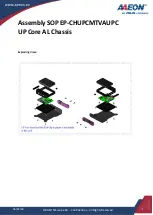
Installing
and
Configuring
Processor
Modules
To
ensure
that
the
system
recognizes
the
new
interface
type you must
shut
down
and
reenable
the
interface
after
changing
the cable
When
setting
up
new
DCE
interface
or changing
the
mode
of
an
interface
from
DTE
to
DCE
or
when
setting
up
loopback
test
you must
also
set
the clock
rate
on
the
interface
If
necessary
you
can
also use software
commands
to
invert the clock
to
compensate
for phase
shifts
caused
by
circuit
delays
or variances
in
cable
lengths
The
default
configuration
for
serial
ports
is
DCE mode NRZ
format
and
16-bit
CRC
error detection
All
serial
interfaces
support
nonretum
to
zero inverted
NRZI
format
and
32-bit error detection
both
of
which
are
enabled
with
software
command
This
section
contains
brief descriptions
and examples
of software
commands
that
you
may
need
when
installing
or changing
the configuration
of
serial
interface
ports
For complete
command
descriptions
and
instructions
refer
to
the
related
software
documentation
Configuring
Timing
Clock
Signals
To
use an
FSIP
port
as
DCE
interface
you must
connect
DCE
port adapter
cable
and
set
the clock
speed
with
the clockrate
command
You
must
also
set
the clock
rate
to
perform
loopback
test This
section
describes
how
use
software
commands
to
set
the clock
rate
on
DCE
port
and
if
necessary
how
to
invert the clock
to
correct
phase
shift
between
the data
and
clock
signals
Setting
the
Clock Rate
All
DCE
interfaces
require
noninverted
internal
transmit
clock
signal
which
is
generated
by
the
FSIP The
default
operation
on
an
FSIP
DCE
interface
is
for
the
DCE
device
FSIP
to
generate
its
own
clock
signal
TxC
and
send
it
to
the remote
DTE
The
remote
DTE
device
returns
the clock
signal
to
the
DCE
FSIP
port
When
using
DCE
interfaces
you must
connect
DCE-mode
adapter
cable
to
the port
and
specify
the
rate
of the
internal
clock
with
the clockrate
configuration
command
followed
by
the bits-per-second
value
In the following
example
the
first
serial
interface
on
an
FSIP
in
interface
processor
slot
2/0
is
defined
as
having
clock
rate
of
Mbps
Router
configure
terminal
Enter
configuration
commends
one
per
line
End
with
CNTL/Z
Router
config
interface
aerial
2/0
Router
config-if
clockrate
2000000
Router
config-if
Router
Following
are acceptable
clockrate
settings
1200
2400 4800 9600
19200
38400
56000
64000
72000
125000
148000
500000
800000
1000000
1300000
2000000
and 4000000
Speeds
above
64 kbps
64000
are
not appropriate
for
EIA/TIA-232
use
EIA/TIA-449
on
faster
interfaces
And
the
faster
speeds
might
not
work
if
your cable
is
too
long
If
you change
an interface
from
DCE
to
DTE
you
can
use
the
no
clockrate
command
to
remove
the clock
rate
although
it
is
not necessary
to
do so The
port
automatically
recognizes
the
DTE
cable
and
ignores
the clock
rate
until
DCE
cable
is
attached
to
the port again
The FSIP
ports
support
full
duplex
operation
at
DS1
1.544
Mbps
and El
2.048
Mbps
speeds
Each
four-port
module
see
the section
Fast
Serial
Interface
Processor
in
the chapter
Product
Overview
is
controlled
by
dedicated
MC68040
processor
and
can
support
up
to
Ti
or
El
interfaces
An
eight-port
FSIP
which
has
two modules
can
support
up
to
Tl
or
El
interfaces
Maintaining
the Router
5-39
Summary of Contents for 7513 Series
Page 1: ......
Page 11: ...Cisco 7513 Hardware Installation and Maintenance ...
Page 121: ...Site Log 2 56 Cisco 7513 Hardware Installation and Maintenance ...
Page 162: ...Troubleshooting the Processor Subsystem 4 10 Cisco 7513 Hardware Installation and Maintenance ...
Page 266: ...Interface Processor LEDs B 16 Cisco 7513 Hardware Installation and Maintenance ...
Page 270: ...C 4 Cisco 7513 Hardware Installation and Maintenance ...
Page 288: ...18 Cisco 7513 Hardware Installation and Maintenance ...







































